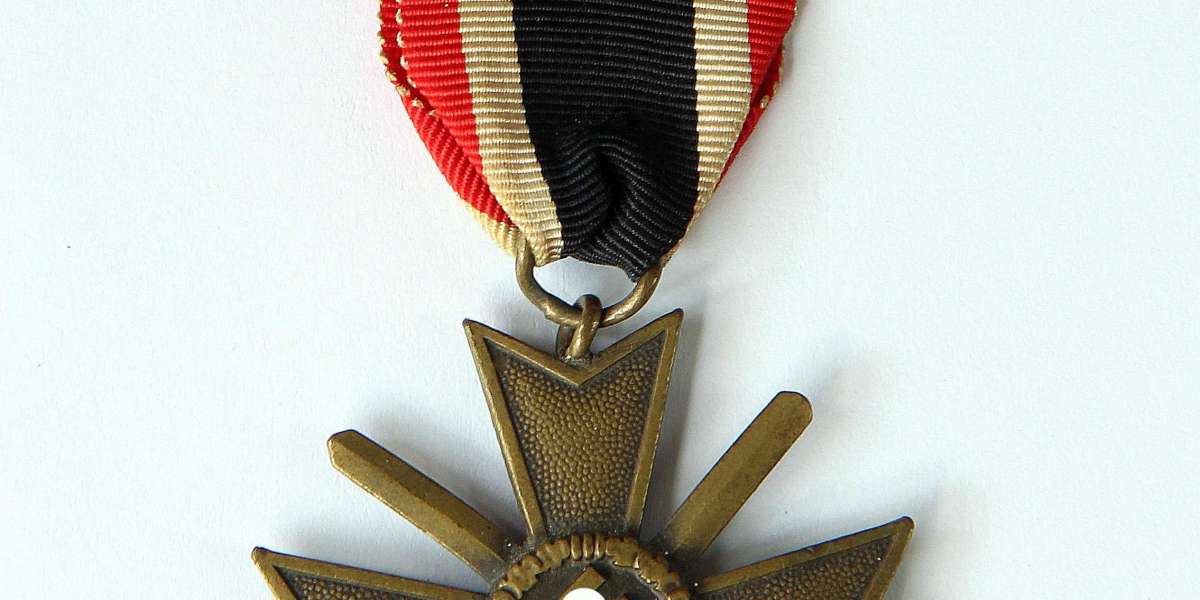The Kriegsverdienstkreuz, or German War Merit Cross, was established on October 18, 1939, by Adolf Hitler to recognize military and civilian contributions to the German war effort outside of direct combat. For collectors, it represents one of the most intriguing and accessible medals from the Second World War, combining rich historical value with a wide range of production variations.
History and Significance
The German War Merit Cross was intended as a counterpart to the Iron Cross, awarded to those who made significant contributions to the war effort but were not engaged in frontline combat. It was given to soldiers in support roles as well as civilians working in administration, industry, science, and logistics.
There were two main types: one with swords, for military personnel, and one without swords, for civilians. By the end of the war, millions of these crosses had been distributed, making it one of the most commonly awarded decorations of the Third Reich.
After 1945, the display of awards featuring the swastika became prohibited in Germany and many European countries. Today, collectors typically encounter either denazified versions (with the swastika removed) or original pieces kept privately for historical preservation.
Classes and Variants
The War Merit Cross existed in several classes. The Second Class (Kriegsverdienstkreuz 2. Klasse) was the most frequently awarded and came suspended from a ribbon. The First Class (Kriegsverdienstkreuz 1. Klasse) was a pin-back version worn directly on the uniform and reserved for higher distinction.
The design followed the traditional Maltese cross form, with a central medallion showing the swastika and the year “1939.” Crosses with swords had two small crossed blades between the arms, symbolizing military service. The ribbon colors were red with white-black-white stripes at the edges for the 2nd Class award.
Materials and Manufacturing
Knowing the materials used is essential for any collector. Authentic pieces from 1939–1945 were produced from zinc, tombac, or occasionally nickel-silver alloys, often with a bronze or silver finish. Early production runs generally display higher-quality metalwork and sharper details, while later wartime examples are known for cheaper zinc alloys that corroded over time.
Each medal was typically marked with a small manufacturer’s code — often a number or “L/” mark — stamped on the reverse. These codes identified the factory or craftsman responsible for the piece, with known makers such as Deschler Sohn or Steinhauer Lück being among the most reputable.
Collectors should pay close attention to texture, patina, and weight. Originals usually feel solid and balanced in the hand, while reproductions tend to be lighter, made from cheap alloys, and may show casting seams or dull engraving.
Identifying Originals and Avoiding Reproductions
The market for German militaria is full of replicas, so careful examination is crucial.
Appearance and finish — Authentic crosses show fine detail and even striking. The edges are crisp, and the central medallion is well-defined. Reproductions often appear too shiny or overly smooth, with uneven coloring.
Maker marks — Originals feature clearly stamped codes on the reverse or pinback. Absence of such marks or use of incorrect fonts and placements is a warning sign.
Material and weight — Genuine examples are made from solid zinc or tombac and have a noticeable heft. Replicas are frequently made of lightweight alloys or cast metal.
Date and proportions — The “1939” inscription and sword alignment should match documented examples. Any irregular spacing or inconsistent shapes are typical indicators of fakes.
Provenance — Medals that come with original cases, ribbons, or award documents are more likely to be authentic. Always ask the seller for detailed photographs and, if possible, the piece’s history of ownership.
Legal and Ethical Considerations
Because these medals carry Nazi-era symbols, public display is restricted or banned in Germany and several European countries. Collectors should handle and store them responsibly, viewing them as historical artifacts rather than ideological symbols.
In the collecting community, authenticity and preservation are key. Cleaning or altering an original piece can drastically reduce its value, and reproductions should always be clearly labeled as such to avoid confusion in the marketplace.
Conclusion
The German War Merit Cross stands at the crossroads of history and craftsmanship. It honors the unseen efforts that supported a vast wartime machine, yet today serves as a tangible reminder of the complexities of that era. For collectors, understanding the materials, maker marks, and fine details that distinguish authentic examples is essential.
Approached with knowledge and respect, the Kriegsverdienstkreuz remains one of the most fascinating and collectible decorations from the Second World War — a piece of history that continues to tell its story through metal, patina, and the hands that preserved it.


















![Coal Gasification Market Assessment and Growth [2024-2031]](https://www.collcard.com/upload/photos/2024/01/tfILenTEfKVWIgZOdIKl_10_3b78d1b2605c56ecba7a30161debafd8_image.jpg)
